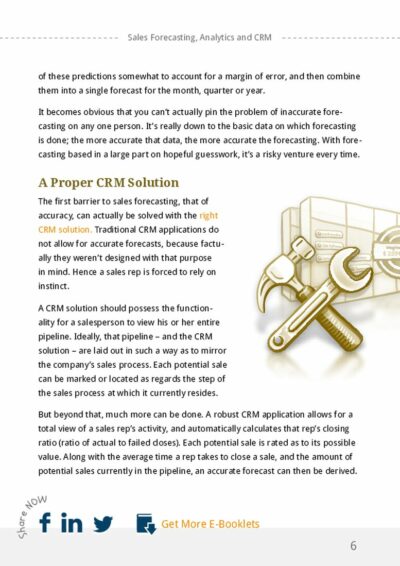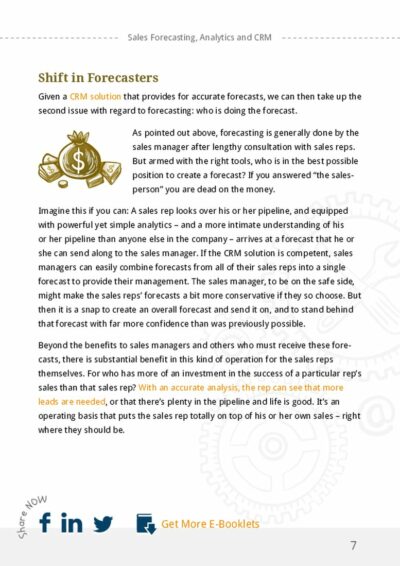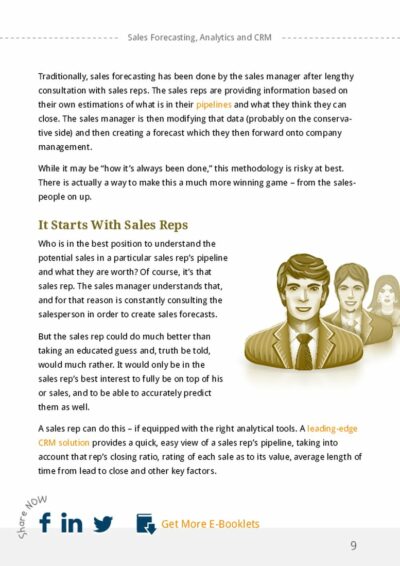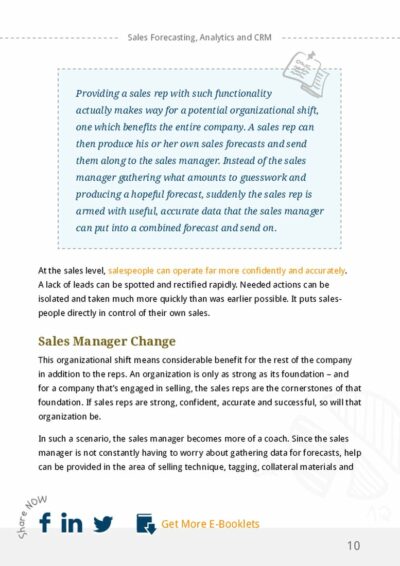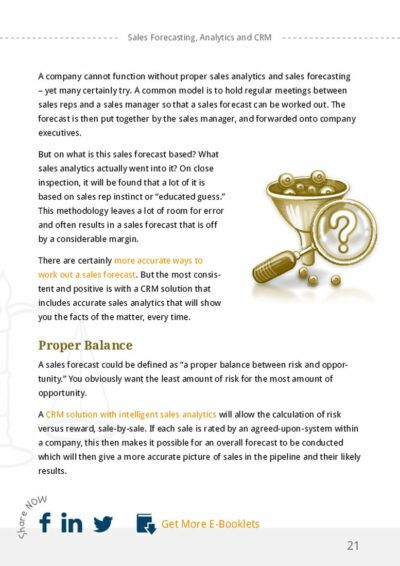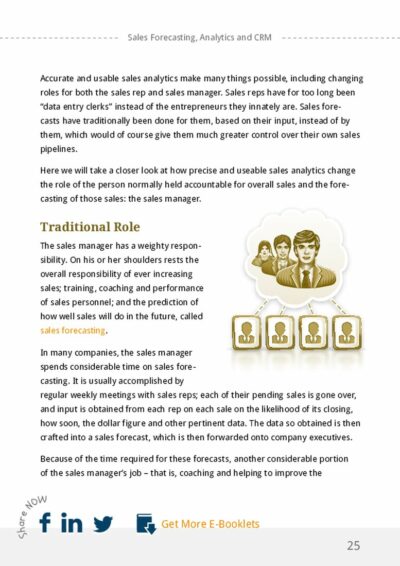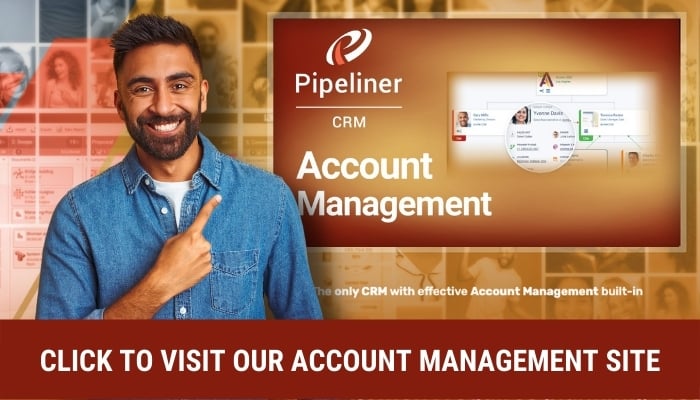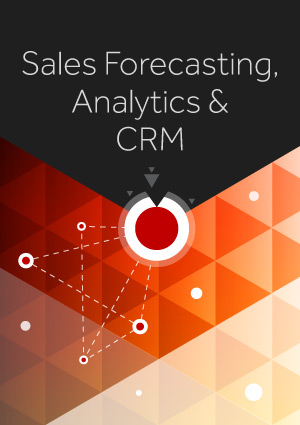
Sales ForecastingForecasting Forecasting is a prediction or calculation of a trend or event likely to occur in the future based on qualitative, quantitative and historical data as well as emergent but relevant factors., AnalyticsAnalytics Analytics is the active study of different types of data with the aim of discovering meaningful patterns and translating these into insight (such as historical analyses and forecasts), or action (such as those intended to improve business performance)., & CRM
With the right tools, your sales forecast can be effective and accurate. The right CRM solutionSolution Solution is a combination of ideas, strategies, processes, technologies and services that effectively helps an organization achieve its goals or hurdle its challenges. helps you get your bearings within the tangled web of sales metricsMetrics Metrics are quantities that are measured and used to:, and see the clear picture of the story your numbers are telling.
Download this free ebook and learn how to properly analyze your sales pipelineSales Pipeline Sales Pipeline is a type of visualization showing the status of each sales prospect in the customer life cycle or sales process., and create an accurate and cost-effective sales forecast.
Chapter 1: CRM Solutions: Reliable and Accurate Sales Forecasting?
Sales forecasts are often done with considerable guesswork, sent along to company management, and everyone crosses their fingers and silently prays that these forecasts are somewhere near correct. If two key issues were solved – accuracy being one of them – everyone from sales reps on up to the chairman of the board could sleep a lot better at night, having far more confidence in those sales forecasts.
Chapter 2: Sales Forecasting: An Organizational Shift
Traditionally, sales forecasting has been done by the sales managerSales Manager Sales Manager is an executive who leads a sales unit, team or department by setting goals and meeting targets, formulating plans and policies, designating tasks, and developing salespeople. after lengthy consultation with sales reps. While it may be “how it’s always been done,” this methodology is risky at best. There is actually a way to make this a much more winning game – from the salespeople on up.
Chapter 3: 6 Key Factors for Accurate Sales Analytics and Forecasting
By actual statistic, sales forecasts – along with closing rates – are generally off by a considerable margin. Here are 6 key factors that, if implemented, will go a long way to greatly improving the accuracy of your sales analytics and forecasting.
Chapter 4: Benefits of Truly Accurate Sales Analytics
There is of course the basic benefit of accurate sales analytics: accurate sales forecasts. But there are numerous other benefits which should also be taken into accountAccount Account refers to a record of primary and background information about an individual or corporate customer, including contact data, preferred services, and transactions with your company., and act as further motivations for companies to move beyond the considerable degree of speculation that commonly dominates today’s sales forecasting.
Chapter 5: Sales Analytics and CRM Solutions
The most consistent and positive way to work out a sales forecast is with a CRM solution that includes accurate sales analytics that will show you the facts of the matter, every time.
Chapter 6: Sales Analytics: Changing Role of the Sales Manager
Here we will take a closer look at how precise and usable sales analytics change the role of the person normally held accountable for overall sales and the forecasting of those sales: the sales manager.
Learn More About Pipeliner CRM
Take a no-obligation 14 day trial of Pipeliner CRM.
No credit card info required – just experience for yourself how it could impact your sales.
Additional Resources
This ebook is on the subject of “Win Together.” It falls under the same context as“win-to-win” described in my book Network Selling: Guarantee Success for the Digital Age. Today, this aspect of sales is more important than ever, and must also be part and parcel of CRM solutions.
“For some years I’ve been saying that, as a society, we’re in the midst of a transformation. Given what’s happened in the last couple of years, there’s no one left who is disagreeing with me! It’s become very obvious.”
 Nikolaus Kimla, CEO at Pipelinersales, Inc.
Nikolaus Kimla, CEO at Pipelinersales, Inc.A common term in sales today is EQ, which stands for “emotional I.Q.” It means the skill a salesperson has in reading emotions and utilizing them in sales. It means empathy and a number of other abilities. The short version is, it’s an I.Q. when it comes to emotions. But just as with our Network Selling model, E.Q. isn’t just for sales, either. It’s actually the missing factor in human interactions, for confrontation—a common “tool” in human interactions—doesn’t actually handle anything.
“You can have everything in life you want if you will just help enough other people get what they want.”
 Zig Ziglar
Zig Ziglar
